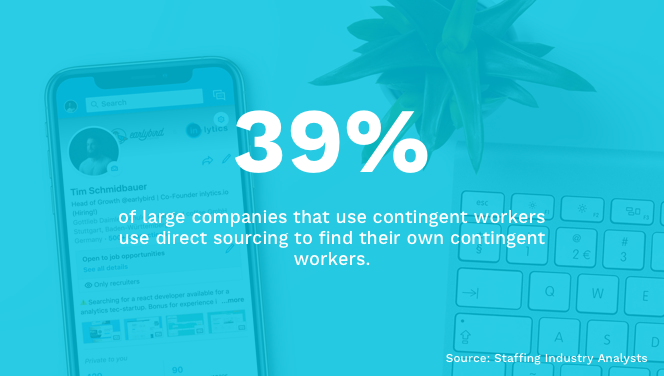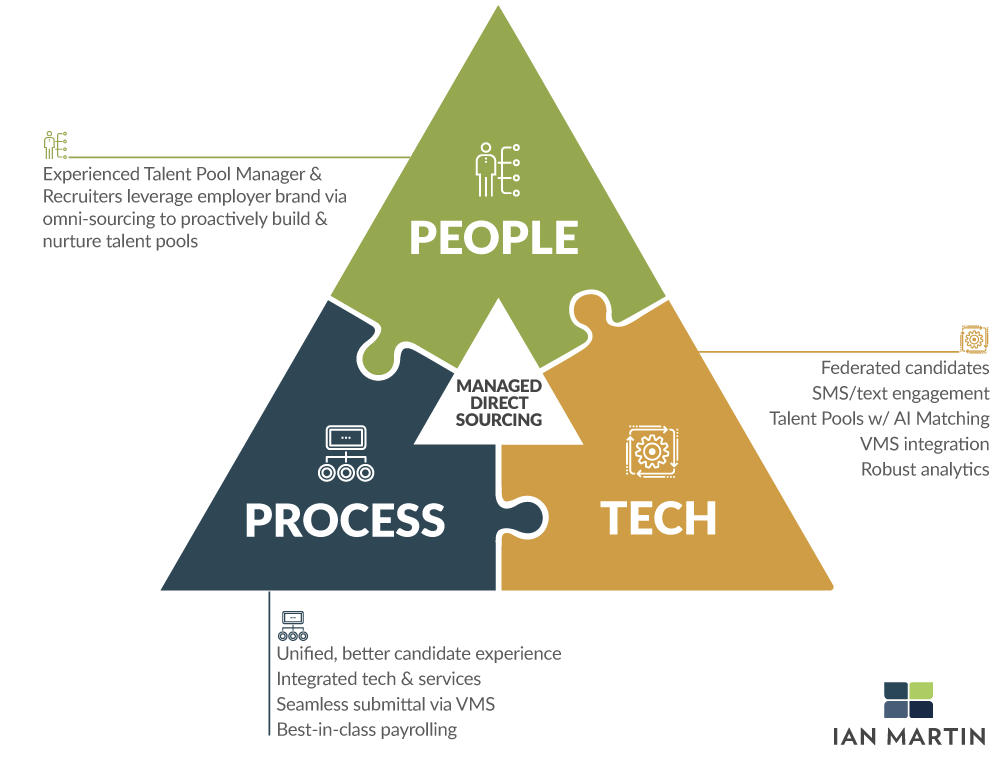The recent period has been quite challenging for companies. Many have had to let people go and abandon their original hiring plans, cut their recruitment budgets and rethink who and when they hire.
They are now looking for ways to fulfill their workforce needs in cost-efficient ways, including by working with contingent workers. But how can you get these people on board?
One increasingly popular way is with direct sourcing. Let’s take a look at what direct sourcing is and what you need to know about this sourcing method!
What’s in?
- What is direct sourcing (in recruiting)?
- What you need to know about direct sourcing
- It can benefit your organization in multiple ways.
- Direct sourcing isn’t for every organization.
- There are various direct sourcing options you can use to help you build your pool of independent talent.
- It enables you to scale your workforce quickly.
- A lot of companies are put off direct sourcing because they think it means a lot of work.
- Engagement is extremely important.
- Ensuring compliance with local employment laws and regulations is crucial.
- You can try direct sourcing with a pilot.
- Successful direct sourcing doesn’t happen overnight.
Like what you see?
Don’t miss out. Subscribe to our quarterly digest to get the latest TA and TM resources delivered right to your inbox.
What is direct sourcing (in recruiting)?
In the current climate where companies are having to rethink their recruitment strategy due to restricted hiring budgets, but are still facing a skills shortage, one strategy that is growing in popularity is to tackle this issue by embracing flexibility rather than stability.
How? With direct sourcing.
Direct sourcing is a method of identifying suitable candidates for your available opportunities by building your very own pool of instant access freelance, contingent or temporary talent, not via a third party such as a recruiter. Direct sourcing removes your reliance on third party staffing and recruitment agencies by going directly to the labor market yourself, to hire contingent workers for temporary project work or as full-time employees.
This directly sourced talent pool is one that consists of top tier candidates that you compliantly source, manage, engage and re-engage directly, as and when you require them, usually on a project to project basis.
Your direct sourcing strategy will be different from your regular sourcing strategy for permanent roles, and just as every company has a unique hiring strategy in place, so too will your direct sourcing solution differ to the next organization’s solution. Why? Because your direct sourcing needs will depend on the size of your company, your talent requirements, and most specifically, your recruitment budget.
There are multiple direct sourcing techniques you could use, including:
- Empowering HR staff to scour their own private networks to identify potential contract talent and independent professionals.
- Using your existing recruiting budget and resources to identify top talent from job board postings, your referral programs, as well as the silver and bronze medalists in your ATS – the people who made it to the final rounds in previous job openings, but who didn’t make the eventual cut.
- Reaching out to your procurement and HR partners to help you identify contingent workers they use themselves.
- Create a streamlined direct sourcing process, a centralized engagement program that anyone in your organization can use.

Direct sourcing is an increasingly popular method of finding contingent workers among large organizations. Further 23% of companies plan to use direct sourcing in the near future.
What you need to know about direct sourcing
1. It can benefit your organization in multiple ways.
Direct sourcing can result in:
- Faster hiring. You aren’t relying on third-party recruiters to source top talent for you. Instead, when you use direct sourcing you already have an engaged talent pool to dip into. Having the right people on your books already, engaged and talented workers who are interested in working for you will speed up the hiring process and ensure you fill the gaps that need filling, for as long as they need filling. Faster hiring also allows you to deliver a better candidate experience, as contingent workers can be hired in just 24 hours, if necessary.
- Reduced costs. By implementing direct sourcing you are negating the need to use recruitment agencies, saving you a significant sum of money in fees (these can be up to 30%). Not to mention, when you engage with contractors directly, you can pick and choose who you want to work with based on your available budget and whether they are a cultural fit. When you hire a third party to source top talent for you, they might contract the services of qualified people, way out of your budget, and not a great organizational fit. By keeping it in house, direct sourcing gives you more control over how your recruiting budget is spent.
- Engaging niche talent. If you only need to enlist the skills of niche talent occasionally, having a private pool of this independent talent to dip into makes it much easier to find, engage and re-engage the necessary skilled workers, as and when you require their services. You can also quickly re-engage independent talent who worked for you previously.
- Greater flexibility to only hire people when you need them, i.e. on a project by project basis.
- Protecting your employer brand. Not only does direct sourcing protect your employer brand, making you a client of choice for your contractors, it leverages it because you are only employing employees who are a great fit for your company and culture.
- More referrals. You know how effective referred talent can be – so when you direct source, you can leverage your existing referral program by asking employees to refer contingent talent, people they might not otherwise be able to refer in your standard referral program.
2. Direct sourcing isn’t for every organization.
How do you know if it’s suitable for you? Here are a few things you might want to consider before implementing it in your organization:
- Do you already have a forecasting plan in place to increase your workforce?
- Are you already planning to recruit a lot of contingent workers?
- Are you looking for a cost-effective supplier solution? One where you have more control over sourcing and recruitment?
- Do you need more oversight of your recruitment costs?
If the answers to those questions are yes, then perhaps it is time you thought about implementing a direct sourcing strategy.
3. There are various direct sourcing options you can use to help you build your pool of independent talent.
You will need to decide which one is the right fit for your business. Don’t forget you’ll need the right technology to enable and support direct sourcing. This is an example from Philips–that has their own freelance talent pool–to provide inspiration.

Direct sourcing options might include:
- Talent marketplace – This is precisely what it sounds like. A marketplace where people with specific skills make themselves available for hire. Talent marketplaces can be B2C i.e. Toptal or Graphite, or peer2peer i.e. Uber.
- Freelance Management Systems – With so many people opting to work freelance, a wealth of platforms have emerged that puts technology to work to provide an end to end solution for all parties, taking care of storing talent, posting projects, filling the projects, managing your onboarding, and invoicing too i.e. MBO’s marketplace.
- Talent network – This is where you would store independent talent you’ve engaged previously. The key feature of this network is that it consists of people you already know. This network could be private i.e. to an HR manager or an open network for the whole company to dip into.
4. It enables you to scale your workforce quickly.
For example, if you get a new project or client, you can get the necessary people to work for you very fast because you already have a database of pre-qualified, pre-vetted candidates.
5. A lot of companies are put off direct sourcing because they think it means a lot of work.
But in truth, you don’t need to reinvent the wheel – there are countless, proven talent acquisition technologies and recruitment marketing technology you can rely on to help you find ways to pre-qualify candidates.
- You can ask candidates basic questions about their availability and interest in different projects, and samples of previous work.
- You could set up a short assessment for your candidates to help you determine if they have what it takes to work in a certain role – this is especially useful if you’re hiring a lot for similar roles.
- You can have candidates undertake a personality questionnaire to see how well they would fit into your existing company culture and if they would be in line with how you want your clients to see your organization.
- You can automate your recruiting processes.
- You can utilize data analytics.
- You can use technology to provide a seamless candidate experience at every touchpoint.
Direct sourcing doesn’t mean you have to do it alone just because you’ve forfeited the hand-holding of a third-party recruiter.
6. Engagement is extremely important.
When your direct source talent pool consists of so many people – current and former employees, freelancers, contractors, silver and bronze candidates, engagement should be top of your priority list.
You need to engage and re-engage the potential contingent workers in your talent pool so that you can easily reach out when you need them. You’ll need the right tools to achieve this i.e. SMS, chatbot.
7. Ensuring compliance with local employment laws and regulations is crucial.
If you’re using direct sourcing, you need to make sure that when you’re hiring the contractors or independent workers, everything is according to local and national employment laws.
You want to avoid worker misclassification – employers who are found to misclassify an employee can face serious financial penalties, and ignorance of the law isn’t an excuse.
Also, if you’re a global brand or you’re recruiting globally, remember that different countries have different employment laws. Meaning that one country’s worker classification can vary drastically to that of another country. You don’t want to fall foul just because you didn’t realize the difference.
8. You can try direct sourcing with a pilot.
If you’re not sure whether or not direct sourcing is the right strategy for your organization, you can start with a pilot. For example, by building a talent pool for one role or multiple positions in similar roles, in one location.
Set the criteria for what a successful pilot will look like and then measure KPIs to see how you get on. When you’re satisfied with how the pilot went, then you can begin to make a gradual transition of the whole process across the company.

Ian Martin points out the important elements of a direct sourcing process.
9. Successful direct sourcing doesn’t happen overnight.
One thing you need to note is that building a direct source talent pool doesn’t happen quickly. This is a cohort of highly-skilled, sometimes very niche contingent workers who can turn your business into an agile workforce and take your business to the next level.
To get it right, you need to make sure you spend the time building and maintaining your talent pool in order to take advantage of it.
Over to you
Direct sourcing can be a great strategy to engage and hire temporary workers for your organization. It can help you deal with your fluctuating workforce needs during periods of uncertainty. However, you’ll need to invest some significant resources into making it work.
Remember that you don’t need to roll out a full-blown direct sourcing strategy immediately. Do your research and find out ways how you can test if it’s the right way of finding contingent workers for you.


